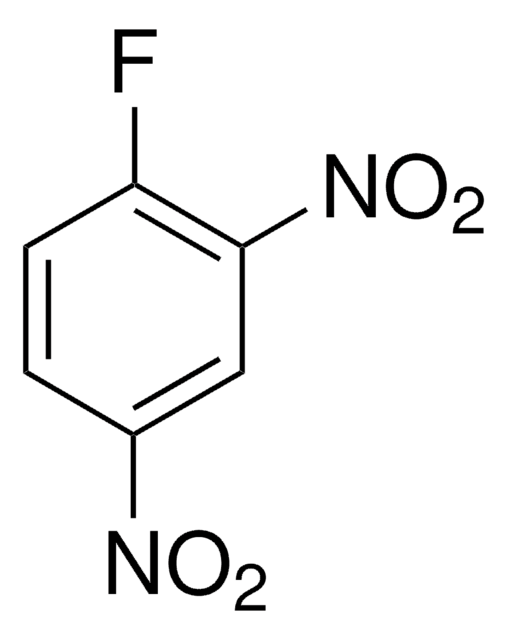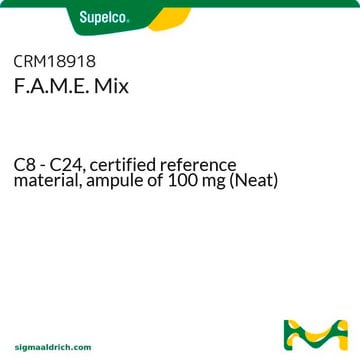42085
1-Fluoro-2,4-dinitrobenzene
purum p.a., ≥98.0% (GC)
Synonim(y):
2,4-Dinitro-1-fluorobenzene, DNFB, DNPF, FDNB, Sanger reagent
About This Item
Polecane produkty
klasa czystości
purum p.a.
Próba
≥98.0% (GC)
Postać
liquid
współczynnik refrakcji
n20/D 1.569 (lit.)
tw
178 °C/25 mmHg (lit.)
mp
25-27 °C (lit.)
gęstość
1.482 g/mL at 25 °C (lit.)
ślady kationów
Ca: ≤50 mg/kg
Cd: ≤50 mg/kg
Co: ≤50 mg/kg
Cu: ≤50 mg/kg
Fe: ≤50 mg/kg
K: ≤100 mg/kg
Na: ≤100 mg/kg
Ni: ≤50 mg/kg
Pb: ≤50 mg/kg
Zn: ≤50 mg/kg
temp. przechowywania
2-8°C
ciąg SMILES
[O-][N+](=O)c1ccc(F)c(c1)[N+]([O-])=O
InChI
1S/C6H3FN2O4/c7-5-2-1-4(8(10)11)3-6(5)9(12)13/h1-3H
Klucz InChI
LOTKRQAVGJMPNV-UHFFFAOYSA-N
Szukasz podobnych produktów? Odwiedź Przewodnik dotyczący porównywania produktów
Powiązane kategorie
Opis ogólny
Zastosowanie
- For aminoglycoside compounds such as amikacine, tobramycine, gentamycine, sisomycine, neamine, neomycine-B and neomycine-C.
- To examine the kinetic analysis and analytical uses of reaction with thiols in the presence of several surfactants.
Hasło ostrzegawcze
Warning
Zwroty wskazujące rodzaj zagrożenia
Zwroty wskazujące środki ostrożności
Klasyfikacja zagrożeń
Acute Tox. 4 Oral - Eye Irrit. 2 - Skin Irrit. 2 - Skin Sens. 1 - STOT RE 2 - STOT SE 3
Organy docelowe
Respiratory system
Kod klasy składowania
11 - Combustible Solids
Klasa zagrożenia wodnego (WGK)
WGK 3
Temperatura zapłonu (°F)
327.2 °F
Temperatura zapłonu (°C)
164 °C
Środki ochrony indywidualnej
dust mask type N95 (US), Eyeshields, Faceshields, Gloves
Certyfikaty analizy (CoA)
Poszukaj Certyfikaty analizy (CoA), wpisując numer partii/serii produktów. Numery serii i partii można znaleźć na etykiecie produktu po słowach „seria” lub „partia”.
Masz już ten produkt?
Dokumenty związane z niedawno zakupionymi produktami zostały zamieszczone w Bibliotece dokumentów.
Klienci oglądali również te produkty
Nasz zespół naukowców ma doświadczenie we wszystkich obszarach badań, w tym w naukach przyrodniczych, materiałoznawstwie, syntezie chemicznej, chromatografii, analityce i wielu innych dziedzinach.
Skontaktuj się z zespołem ds. pomocy technicznej















